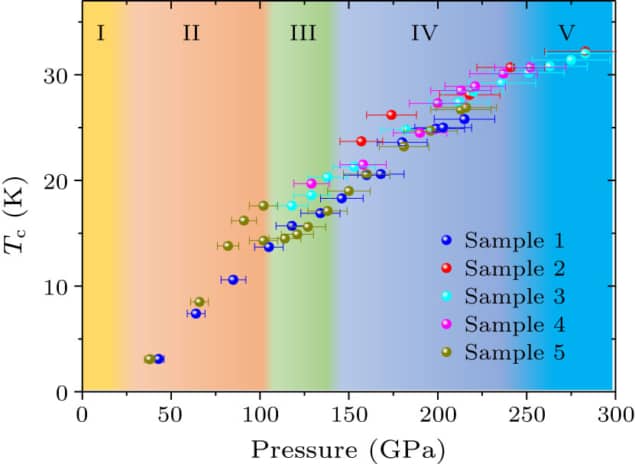Scandium breaks temperature record for elemental superconductors
07 Dec 2023 Isabelle Dumé
Scandium is the only known elemental superconductor to have a critical temperature in the 30 K range. This phase diagram shows the superconducting transition temperature (Tc) and crystal structure versus pressure for scandium. The measured results on all the five samples studied show consistent trends. (Courtesy: Chinese Phys. Lett. 40 107403)
Scandium remains a superconductor at temperatures above 30 K, making it the first element known to superconduct at such a high temperature. The record-breaking discovery was made by researchers in China, Japan and Canada who subjected the element to pressures of up to 283 GPa – around 2.3 million times atmospheric pressure at sea level.
Many materials become superconductors – that is, they conduct electricity without resistance – when cooled to low temperatures. The first superconductor to be discovered, for example, was solid mercury in 1911, and its transition temperature Tc is only a few degrees above absolute zero. Several other superconductors were discovered shortly afterwards with similarly frosty values of Tc.
In the late 1950s the Bardeen–Cooper–Schrieffer (BCS) theory explained this superconducting transition as the point at which electrons overcome their mutual electrical repulsion to form so-called “Cooper pairs” that then travel unhindered through the material. But beginning in the late 1980s, a new class of “high-temperature” superconductors emerged that could not be explained using BCS theory. These materials have Tc above the boiling point of liquid nitrogen (77 K), and they are not metals. Instead, they are insulators containing copper oxides (cuprates), and their existence suggested it might be possible to achieve superconductivity at even higher temperatures.
The search for room-temperature superconductors has been on ever since, as such materials would considerably improve the efficiency of electrical generators and transmission lines, while also making common applications of superconductivity (including superconducting magnets in particle accelerators and medical devices like MRI scanners) simpler and cheaper.
A simple platform for studying superconductivity
Elemental superconductors have attracted considerable attention during this search because they provide such simple platforms for studying superconductivity. Roughly 20 elements are known to be superconductors at ambient pressures. Of these, niobium has the highest Tc, at around 9.2 K. A further 30 elements become superconducting at high pressures, but the previous record Tc in this group was just 26 K, for the element titanium.
In earlier work, researchers reported that scandium (Sc) undergoes four structural phase transitions at pressures of about 23, 104, 140 and 240 GPa, producing Sc II, Sc III, Sc IV and Sc V, respectively. Scandium was also known to become superconducting at 21 GPa with a Tc of around 0.35 K, and previous experiments had pushed this Tc as high as 19.6 K at 107 GPa, near the phase boundary between the Sc II and Sc III phases.
In the new work, which lead researcher Changqing Jin describes as “a follow up to our previous discovery” of superconductivity in titanium at 26 K, a team from the Institute of Physics, Chinese Academy of Sciences (IOPCAS) and the School of Physics, University of Chinese Academy of Sciences (UCAS) increased the pressure on scandium to 238 GPa. In doing so, they discovered a Tc of above 30 K in the V phase of the element. The result means that scandium is the only known elemental superconductor to have a Tc in the 30 K range, and the team suggests this value may go even higher with further compression.
In a separate study, a team of researchers led by Chen Xianhui from the University of Science and Technology of China (USTC) of the Chinese Academy of Sciences (CAS) and Sun Jian from Nanjing University independently obtained similar results showing that the Tc of scandium increases monotonically into the 30 K region as pressure is increased. Both teams obtained their results by loading their scandium sample into a diamond anvil cell and measuring the element’s conductivity as a function of temperature as they increased the pressure. Such experiments are technically challenging, and several attempts were necessary before they reached the high pressure of 283 GPa.
Pressure-induced electron transfer
In the BCS framework, superconductivity stems from interactions between electrons and vibrations in the material’s crystal lattice (phonons). According to the researchers, scandium fits neatly into this picture, as high pressures cause electrons to move out of the element’s 4s orbitals and into its 3d ones, increasing the electron-phonon coupling.READ MORE

“The above 30 K Tc observed in the Sc V phase not only sets a new record for elemental Tc, but also points to a fresh strategy for exploring high Tc superconductivity in diverse elemental solids,” Jin tells Physics World. “Such elements could be promising for potential applications in extreme environments.”
Jin adds that he and his colleagues are now trying to reach high Tc phases at lower or even near-ambient pressure by introducing “chemical pressure”, which involves substituting or adding chemical entities to a solid network.
The work is detailed in Chinese Physics Letters.

Isabelle Dumé is a contributing editor to Physics World
FROM PHYSICSWORLD.COM 8/12/2023

Δεν υπάρχουν σχόλια:
Δημοσίευση σχολίου